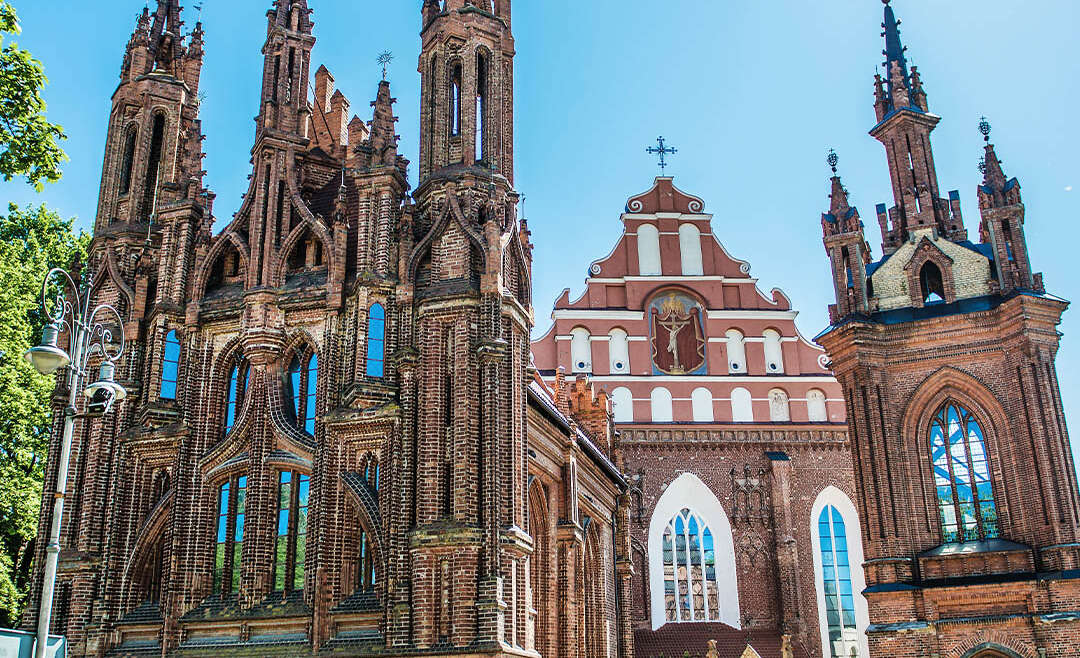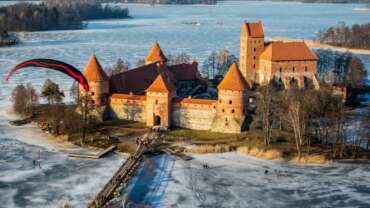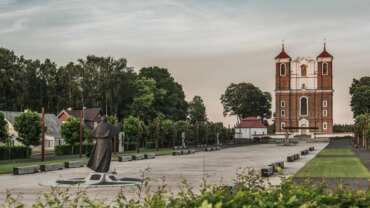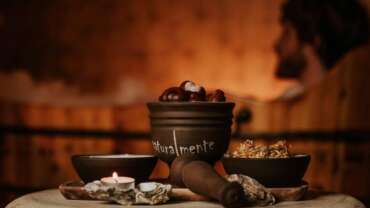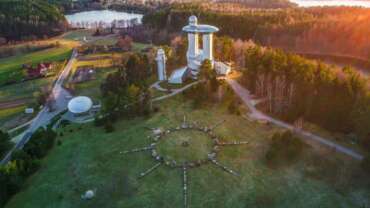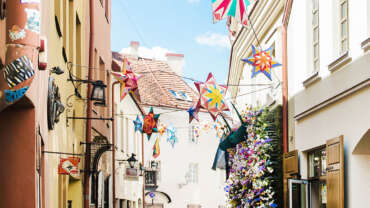Places to visit in Lithuania
The Republic of Užupis
Užupis may be the smallest district in Vilnius, but what it lacks in size it makes up for in style and character. Nestled on the banks of the Vilnelė River, the area is a hive of creativity and eccentricity, attracting the city’s artists, intellectuals and entrepreneurs. The spirit of the district is best embodied by its constitution, a somewhat ironic list of ordinances that is displayed on the walls as you enter.
You can take the pretty path alongside the river under Užupis Bridge, and even try your luck on the Swing of Destiny.
Gediminas Castle Tower
Visible from multiple points across the city, Gediminas Castle Tower is the main symbol of Vilnius and a great place to start your tour of the city. Crowning Gediminas Hill, the Castle offers the perfect spot to catch a panorama of Vilnius’ UNESCO-listed Old Town. Not only that, it is also a great place to soak in a golden sunset on cloudless days. And for the most historically curious, the Castle Tower also houses a permanent exhibition covering the architecture, armaments and iconography of the city’s past.
The Glass Quarter
Originally a Jewish neighbourhood of goldsmiths, glassblowers, artisans and financiers, this area located between the M. Antokolskio, Gaono, and Žydų streets in the city’s old town became the Glass Quarter in 2018. Now home to a community of boutique owners, jewellers, designers and cafe owners, the Glass Quarter has become synonymous with style and a flair for the fantastic. In fact, during festival times like Christmas and Halloween, you’ll find the streets festooned with lights and decoration. A great place for shopping, or browsing, or cafe hopping, you’ll have the chance to enjoy a luxurious champagne and cake experience under a ceiling of rose petals. The Glass Quarter is a must visit.
MO Museum
Designed by architectural wunderkind Daniel Libeskind, the MO Museum is the city’s newest jewel. Its award winning structure is a real eye opener both inside and outside. In fact, the museum’s central staircase, modelled after a DNA sequence, has become a popular site for Instagrammers. But it’s not about the building – focusing primarily on contemporary art, the museum hosts a number of exhibitions throughout the year that highlight the best in Lithuanian and Baltic art.
Museum of Occupations and Freedom Fights
The (KGB) Museum of Occupation and Freedom Fights is the only museum of its type in the Baltic States. Located in the building that was the headquarters of the Soviet punitive authorities (NKVD and NKGB-MGB-KGB) from 1940 to 1991, the museum offers a sobering meditation on the country’s troubled past.
On the first floor of the museum, in the office of the former deputy head of the MGB (KGB) visitors can see documents, photos, maps and other objects that illustrate the Sovietization of the country. Meanwhile, on the same floor, exhibits presenting the territorial structure and military organisation of guerrilla units, give visitors a clear idea of the aspirations of the country’s freedom fighters, as well as their daily activities and mode of life. Continuing on the same floor, the exhibition “An Unequal Fight” lays bare the NKVD-NKGB fight against the country’s armed resistance.
Moving to the second floor, visitors can see displays recounting the experiences of Lithuanian prisoners in the gulags, as well as the deportations of Lithuanian citizens. This floor also contains a reconstruction of a KGB surveillance room, containing authentic listening equipment of the time, as well as the furnishing and interior details that were common in the day. For visitors looking to fully understand the country’s recent history, this museum is a must.
Literatai Street
Rumoured to be named in honour of the 19th-century poet Adomas Mickevičius (Adam Mickiewicz) who lived there, Literatai Street is a popular draw for foreign tourists and Lithuanians alike. What attracts the crowds are the hundreds of unique works of art that decorate the street’s walls. Composed from wood, metal and glass, each individual piece refers to the work of a famous author somehow related to Vilnius.
The Cathedral Basilica of St. Stanislaus and St. Ladislaus
This temple is a symbol of the Christianization of Lithuania. The Cathedral Basilica of St Stanislaus and St Ladislaus of Vilnius was built in the very centre of the city, on the site of a former pagan temple. Standing next to the city’s defensive castle, the Cathedral has survived the most celebrated and dramatic events in the history of Vilnius and Lithuania.
The Cathedral has been rebuilt several times over the centuries, attracting the talents of famous local and international architects and artists. The present building is in the Classicism style (created by the architect Laurynas Stuoka-Gucevičius), although its walls contain traces of Gothic, Renaissance and Baroque architecture.
In front of the Cathedral stands a 57m high bell tower. This distinctive structure is a popular draw for tourists, who can climb the belfry steps to access a panoramic view of the Cathedral square.
Vilnius University / Presidential Palace
Did you know that Vilnius University is one of the oldest universities in the world? With 12 faculties and around 23,000 students, it is one of the country’s leading academic institutions. Vilnius University’s oldest campus, in which the university’s administration is situated, houses 3 faculties: the faculty of history, the faculty of philology and the faculty of philosophy. There is also a library with more than 5 million printings and old manuscripts. Among them is one of the only two copies in existence of the first Lithuanian book, the Catechism of Martynas Mažvydas.
Next to the university, you will find the palatial formal residence of the President of the Republic of Lithuania. Those wishing to take a look at the Presidential premises can register for a free tour of the Office of the President of the Republic of Lithuania. The Presidential Palace was built in Simonas Daukantas Square, which is named in honour of Simonas Daukantas, a graduate of Vilnius University who wrote the first history of Lithuania in Lithuanian.
Palace of the Grand Dukes of Lithuania
Opened in 2013, The Residence of the Grand Dukes of Lithuania is a modern imagining of the original castle that stood on the site from the second half of the 13h century. This building, the so-called “Lower Castle”, was the seat of successive Lithuanian Grand Dukes, beginning with the Gediminid dynasty. The middle of the 17th century saw its untimely destruction at the hands of the marauding Russian army.
Visually, the modern incarnation of the Palace of the Grand Dukes is a novel potpourri of architecture styles. This reflects the original building, which assumed a number of successive architectural styles in its lifetime, from the Gothic to the Renaissance.
The building’s many grand and spacious rooms now play host to concerts and exhibitions all year round.
St. Anne’s Church and Bernardine Church ensemble
This church, which has remained almost unchanged for five centuries, is one of the most beautiful and probably the most famous buildings in Vilnius. It is a masterpiece of the late Gothic style, wrapped in many enigmatic legends. The most famous of which is that upon seeing St. Anne’s Church, Napoleon Bonaparte expressed a desire to take the building back to Paris on the palm of his hand.



